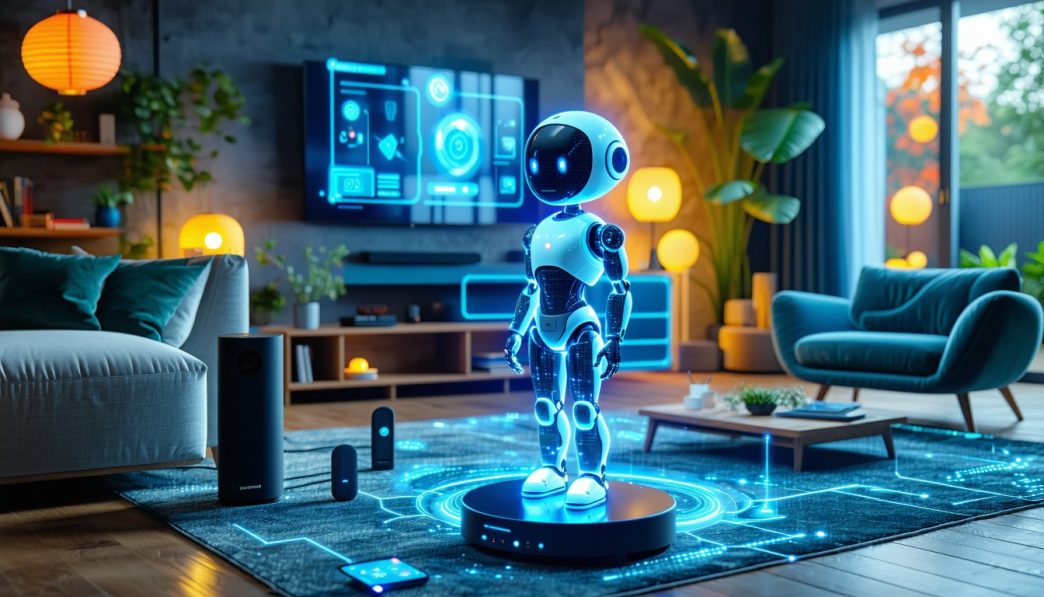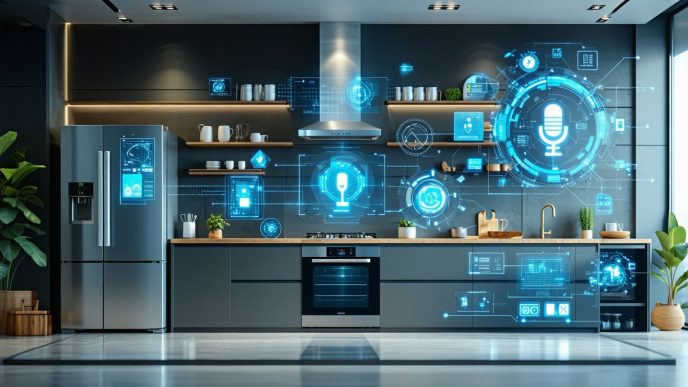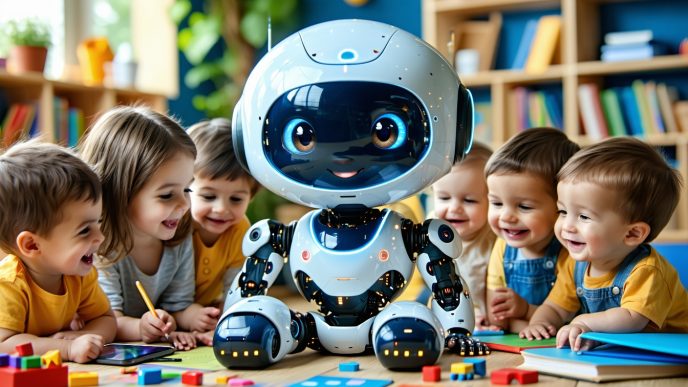The Rise of AI Assistants in Smart Homes
The integration of AI assistants into smart homes has fundamentally transformed the way individuals interact with technology. This section explores the evolution of smart home technology, the role of AI assistants in automating household tasks, and the growing connectivity with various smart devices.
Evolution of Smart Home Technology
Smart home technology has evolved significantly over the past few decades, transitioning from basic remote-controlled devices to sophisticated systems that enable comprehensive home automation. Innovations in wireless communication, internet connectivity, and sensor technology have paved the way for these advancements.
| Milestone | Description |
|---|---|
| 1990s | Introduction of basic home automation systems and remote controls. |
| 2000s | Rise of internet-connected devices allowing for remote monitoring and control. |
| 2010s | Integration of voice recognition technology leading to the development of AI assistants. |
| Present | Seamless connectivity with a myriad of smart devices for holistic home management. |
This evolution has made it easier for homeowners to automate repetitive tasks and monitor their home environments remotely, reflecting a growing desire for convenience and comfort.
Role of AI Assistants in Home Automation
AI assistants serve as the central control hub in smart homes, enabling users to manage various devices through voice commands or smartphone applications. These assistants can perform a multitude of tasks, from adjusting the thermostat to dimming the lights.
Users benefit from the capabilities of AI assistants in several ways:
- Voice Control: Users can control devices through natural language commands, making interactions intuitive.
- Scheduling: AI assistants can be programmed to execute commands on a set schedule, enhancing automation.
- Learning Behavior: Many AI assistants learn user preferences over time, allowing for personalized automation.
This sophisticated control enhances user experience and convenience, allowing them to focus on more important tasks and enjoy their home environments.
Growing Integration with Smart Devices
As smart home technology evolves, the integration of AI assistants with smart devices continues to expand. A variety of devices, including lights, thermostats, security systems, and appliances, can be seamlessly connected to AI assistants.
| Device Type | Integration Benefits |
|---|---|
| Smart Lights | Control brightness and color temperature with voice commands. |
| Smart Thermostats | Automate heating and cooling based on user preferences and schedules. |
| Security Systems | Monitor and control home security features remotely. |
| Smart Appliances | Streamline cooking and cleaning tasks through automated functions. |
This growing ecosystem showcases the versatility of AI assistants and their ability to interact with diverse technology, enhancing the overall smart home experience.
Understanding the evolution and role of AI assistants in smart homes highlights their significance in modern living. These assistants not only streamline daily tasks but also lay the foundation for future advancements in home automation and technology. For those keen on exploring various applications of AI assistants, the insights around ai assistants and smart homes provide further valuable perspectives.
Smart Lighting Systems
Smart lighting systems have rapidly become a staple in modern smart homes, offering enhanced control and flexibility. By integrating these systems with AI assistants, homeowners can enjoy a seamless lighting experience tailored to their needs.
How AI Assistants Control Lighting
AI assistants play a pivotal role in the operation of smart lighting systems. These assistants utilize voice commands and mobile applications to control lighting throughout the home. Users can easily adjust light levels, change colors, and set schedules simply by communicating with their AI assistant. This integration allows for a hands-free approach to managing lighting.
The following table summarizes common commands that users might issue to their AI assistants regarding lighting control:
| Command Type | Example Command |
|---|---|
| Turn On/Off | “Turn on the living room lights” |
| Adjust Brightness | “Dim the bedroom lights to 50%” |
| Change Color | “Set the kitchen lights to blue” |
| Set Schedules | “Turn on the porch lights at sunset” |
AI assistants enhance the user experience by providing dynamic control options through both voice and app-based interactions. This capability significantly increases convenience and accessibility for homeowners.
Benefits of Integrating Lighting with AI Assistants
Integrating smart lighting with AI assistants offers numerous advantages. The flexibility provided by voice commands ensures effortless interaction, while automated scheduling helps create a personalized lighting environment. Below are some key benefits of this integration:
| Benefit | Description |
|---|---|
| Convenience | Users can control lighting without physical effort or manual switches. |
| Energy Efficiency | Smart lighting can be scheduled to turn off when not in use, reducing energy consumption. |
| Enhanced Ambiance | Customizable colors and brightness levels allow users to set the desired mood for different occasions. |
| Improved Safety | Automatic outdoor lighting can enhance security by simulating presence, deterring potential intruders. |
Moreover, integrating lighting with AI assistants enhances home automation systems, allowing lights to respond to other environmental controls such as thermostats and security systems. This interconnectedness enables the creation of sophisticated routines, exemplifying the potential of AI assistants and smart homes to simplify and enhance daily living.
For more information on how these technologies interact with various smart appliances, explore our content on AI assistants in appliances.
Thermostat Control Through AI Assistants
Regulating Home Temperature with AI
AI assistants play a significant role in managing home temperatures through smart thermostats. These devices offer users the ability to control heating and cooling settings with simple voice commands or via mobile applications. By integrating with AI assistants, smart thermostats can learn a user’s preferences over time, adjusting settings automatically to maintain comfortable living conditions.
The capability to interact with AI assistants allows for convenient temperature regulation. Users can request specific settings, such as, “Set the thermostat to 72 degrees,” or “Lower the temperature in the living room.” Additionally, these systems can make adjustments based on occupancy and time of day, ensuring an energy-efficient approach to home climate control.
| Functionality | Description |
|---|---|
| Voice Control | Adjust temperature using voice commands through AI assistants. |
| Learning Capabilities | Smart thermostats learn user preferences for better automation. |
| Scheduling | Users can set schedules for heating and cooling based on their routines. |
Energy Efficiency and Comfort Benefits
Utilizing AI assistants for thermostat control brings various energy efficiency and comfort benefits. Homes equipped with smart thermostats can identify when residents are away and automatically adjust the heating or cooling accordingly, reducing unnecessary energy consumption. This proactive approach not only saves money on utility bills but also contributes positively to environmental sustainability.
Research indicates that homes with smart thermostats can experience significant reductions in energy usage. The following table summarizes typical energy savings associated with using AI-powered thermostats:
| Scenario | Estimated Energy Savings (%) |
|---|---|
| Constant Temperature Control | 10 – 15% |
| Adaptive Scheduling | 15 – 20% |
| Learning User Preferences | 20 – 30% |
By prioritizing energy efficiency, smart thermostats contribute to a more sustainable home environment while ensuring that comfort is maintained throughout the day. This synergy between AI assistants and smart thermostats enhances not only the convenience of managing home temperatures but also the overall efficiency of energy use. For more insights on AI assistants, including various use cases, refer to our article on AI assistant use cases.
Enhancing Home Security with AI Assistants
AI assistants play a significant role in enhancing home security systems. Their integration with various security devices creates a comprehensive safety net, offering homeowners real-time monitoring and control over their security infrastructure.
Monitoring and Controlling Security Systems
AI assistants allow users to monitor and control their security systems conveniently through voice commands or smartphone applications. Homeowners can access important features such as:
- Real-time alerts: Notifications on suspicious activity, unauthorized access, or important security events.
- Camera feeds: Accessing video feeds from security cameras to check on various areas of the home.
- Smart locks: Controlling door locks remotely, enabling users to lock or unlock doors without a physical key.
| Feature | Description |
|---|---|
| Real-Time Alerts | Instant notifications sent to the user’s device |
| Remote Camera Access | View live feeds from connected security cameras |
| Smart Lock Control | Lock and unlock doors via smartphone or voice |
| Integration with Sensors | Monitor motion, doors, and windows for breaches |
By centralizing these functionalities through AI assistants, users can easily maintain their home security from anywhere at any time.
Integrating AI for Enhanced Safety Features
The capabilities of AI assistants extend beyond basic monitoring. Advanced safety features can be integrated into the home security system, including:
- Facial recognition technology: Some systems can recognize family members and notify the user of unfamiliar faces.
- Automated routines: AI can set routines to activate security systems when residents leave home or at predetermined times.
- Emergency response integration: AI assistants can be programmed to automatically alert authorities in case of emergencies.
| Safety Feature | Benefit |
|---|---|
| Facial Recognition | Identify family and alert for intruders |
| Automated Security Activation | Set routines for when the home is unoccupied |
| Emergency Response | Contact authorities during a triggered alarm |
These enhanced features not only improve security but also provide convenience and peace of mind for homeowners. For families, the use of AI assistants adds another layer of support, particularly useful for those looking to improve safety measures in their home environments.
Overall, integrating AI into home security systems significantly boosts the effectiveness of monitoring and control, ensuring that families feel safe and secure within their own spaces. For further insights into how AI assistants can bolster safety, including interactions with other devices, refer to our sections on voice powered robots and AI assistants in appliances.
Seamless Integration of AI Assistants
Integrating AI assistants into smart homes allows users to experience enhanced convenience and automation. However, achieving a seamless connection between devices can be challenging. This section discusses how to set up integration across various devices and ensure compatibility and connectivity for optimal performance.
Setting Up Integration Across Different Devices
Setting up AI assistants to work with various devices in a smart home involves several steps. Users typically start by selecting a compatible AI assistant such as Alexa, Google Assistant, or other similar options. The following steps outline this process:
-
Choose an AI Assistant: Determine which AI assistant will serve as the central hub for the smart home. Each assistant has its own ecosystem, which may affect the compatibility of other devices.
-
Select Compatible Devices: Invest in smart devices that explicitly list compatibility with the chosen AI assistant. This includes smart lights, thermostats, and security systems.
-
Install Associated Apps: Download the necessary applications for the AI assistant and the smart devices. This ensures easier management and control.
-
Connect Devices to the Network: Follow the manufacturer’s guidelines to connect each smart device to the home Wi-Fi network and the AI assistant.
-
Use Voice Commands: Once connected, users can begin using voice commands to control interactions among devices. AI assistants simplify this by recognizing commands related to different devices.
The table below summarizes the typical steps involved in setting up AI assistants with smart home devices:
| Step | Description |
|---|---|
| 1. Choose an AI Assistant | Determine the main AI interface for your smart home. |
| 2. Select Compatible Devices | Look for devices that work with the chosen assistant. |
| 3. Install Associated Apps | Download necessary management apps. |
| 4. Connect Devices | Follow guidelines to connect devices to Wi-Fi. |
| 5. Use Voice Commands | Control devices using voice through the AI assistant. |
Ensuring Compatibility and Connectivity
Compatibility is vital for the successful integration of AI assistants with smart devices. Users should consider the following aspects to ensure a smooth connection:
-
Supported Protocols: Ensure that the devices use supported communication protocols like Wi-Fi, Zigbee, or Z-Wave. This affects how they connect and communicate with the AI assistant.
-
Firmware Updates: Regularly check for firmware updates on devices and AI assistants to ensure all systems perform optimally.
-
Testing Connections: After installation, test each device under different scenarios to confirm that they respond appropriately to commands from the AI assistant.
-
Managing Privacy: Users should also be mindful of privacy considerations. Understanding the implications regarding data sharing with AI systems is crucial for a safe smart home experience. For more on this topic, refer to our article on privacy and ai assistants.
Addressing these factors will help users achieve seamless integration of AI assistants in their smart homes. By maintaining compatibility and ensuring reliable connectivity, the benefits of utilizing AI technology can be fully realized. For examples of practical applications, check out our article on ai assistant use cases.
Future Trends in AI-Assisted Smart Homes
The landscape of AI-assisted smart homes continues to evolve rapidly. Advancements in technology are enhancing the capabilities of AI assistants, paving the way for greater integration and user convenience.
Advancements in AI Technology for Home Automation
AI technologies are rapidly advancing, leading to more sophisticated capabilities in home automation. Some of the key trends include:
| Technology Advancement | Description |
|---|---|
| Enhanced Natural Language Processing (NLP) | Improved understanding of user commands, allowing for more fluid interactions. |
| Machine Learning Integration | AI systems learning from user behavior to automate routines and preferences more intuitively. |
| Increased Interoperability | AI assistants becoming more compatible with a wider range of smart devices, improving overall home integration. |
| Smart Learning Algorithms | Devices that optimize energy usage based on historical data and real-time inputs. |
As these technologies progress, AI assistants become more adept at managing various home functions efficiently. This enhances user experience and nurtures a more connected living environment.
Predictions for Future Integration and Capabilities
Looking ahead, several predictions can be made regarding the integration of AI assistants in smart homes:
- Unified Control Interfaces: Users will have access to centralized interfaces for controlling all smart devices, simplifying management and enhancing convenience.
- Personalized Assistant Experiences: AI will curate personalized experiences for users, taking into account individual preferences for lighting, temperature, and entertainment.
- Voice-Powered Robots in Homes: The emergence of voice powered robots will allow for even broader home automation capabilities, functioning in tandem with AI assistants.
- Increased Focus on Privacy and Security: As reliance on AI assistants grows, there will be a heightened focus on privacy and AI assistants, ensuring that user data is protected and secure.
- Assistance for Various Demographics: Development of specialized applications, such as AI assistants for elderly support and tailored services for families, including features specific to AI assistants and kids.
As these predictions materialize, it becomes clear that the future of AI assistants and smart homes is geared towards creating more intelligent, responsive environments that prioritize user comfort and automation. Continuous advancements will make daily life smoother for tech-savvy families and individuals seeking convenience through smart home technologies. For more details on the evolving landscape, read our insights on AI assistant use cases.















